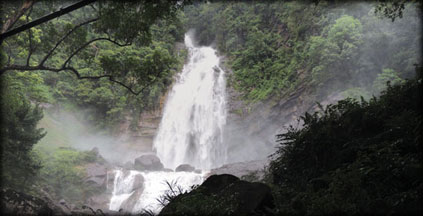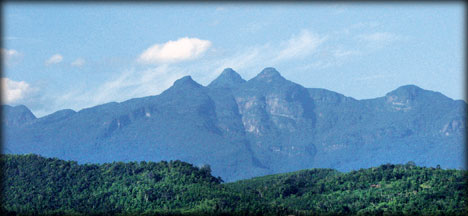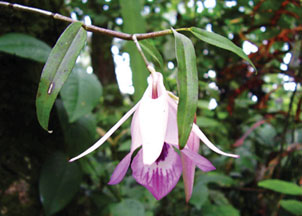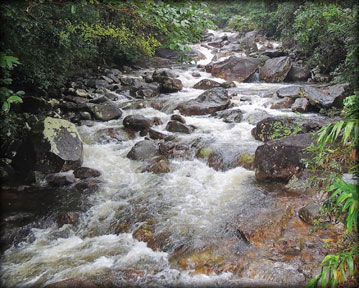Mapalana Ella, a captivating cascade of water
Sri Lanka’s fourth highest waterfall:
By Mahil Wijesinghe
 |
|
A close view of the
cascading water of Mapalana fall |
Waterfall, Nothing can
harm me at all My worries seem so very small With my waterfall I can see
my rainbow calling me Through the misty breeze Of my waterfall
-
Jimi Hendrix
There are 109 waterfalls - big and small - in the Ratnapura district
alone. Water keeps gushing down mountain ledges-sometimes gently,
sometimes playfully and at other times impressively, in sound and fury.
After a month of waiting to go on an expedition with a group of four,
all nature lovers, Chintaka, a self-appointed driver with his 4DR5
Mitsubishi Jeep, Indika, Asitha, with their children and my son and
myself, left on the journey from Ratnapura which is our home town. We
were extremely excited to get our date during the August school vacation
so that our children also could take part in this excursion. So, off we
went on a quick one day trip to a lesser-known waterfall called
‘Mapalana Ella’ at Sri Palabaddala in Ratnapura.
Imposing, high, steep mountains clothed in a mantel of greenery with
patches of white clouds either drifting across or resting atop them
characterise large parts of Sri Pada peak wilderness sanctuary during
rainy days. Human settlements with tea plantations dot the slopes and
the base of the mountains in most places. Dense forests are largely
confined to the mountaintops and deep valleys. In many places rainwater
that gathered in these forests emerge as small waterfalls, making the
Sri Pada Peak wilderness a sanctuary land of waterfalls.
 |
|
The Bana Samanala
mountain range seen from Gilimale |
Our journey branched off from Ratnapura town to Sri Palabaddala via
Gilimale. This road which is motorable up to Sri Palabaddala and then
the flight of steps leads to summit of Sri Pada is extensively used by
the pilgrims to Sri Pada. The weather was rainy and misty and therefore
even the majestic mountains at a distance of a kilometre or so were not
visible.
Although the road was rough in some places as a result of heavy
rains, the drive was enjoyable as the weather was cool, the vegetation
all around was lush and green, and there were richly grown tea
plantations on either side of the road. Small waterfalls were seen all
along the road. Half-dressed children play in front of estate housing
gave the impression that in remote villages they have enough to eat,
they grow all they need in the salubrious climate. After a few customary
views of the meandering Kalu Ganga, we drove to the core area of the
sanctuary of peak wilderness. As we stepped on to the rainforest area,
we found ourselves in a different world. The forest envelopes all senses
and for a moment one feels this is where he belongs. The next instant
you realise you actually are an aberration on nature’s perfectly created
landscape.
True to its name, the Mapalana waterfall dazzles. A milky white foam
bursts forth from apparently invisible hills. The sheet of water that
comes crashing down envelopes the area in a fine mist. As you approach
the spot, the sound of water echoes all around. When you look up,
practically nothing is visible except for the blinding white curtain,
which against the light makes the surrounding rolling hills look blue.
Mapalana is Ratnapura’s, most picturesque waterfall, becoming the
fourth highest in Sri Lanka reaching 141 metres in height in a rocky
formation, perhaps the most mesmerising and liveliest waterfall that is
found in the peak wilderness in Sri Pada sanctuary.
 |
|
Enademic Vesak orchid
flower |
 |
|
Cool strean below the
fall |
According to legend, the fall gets its name from Maapaa-Nana, which
later became mapanana and finally Mapalana. This waterfall consists of
three sections which originates from 1,868 metres high Bena Samanala
(two mountains that flank Sri Pada peak) as the pristine springs which
starts from Sri Pada peak massif and the fall form as a cascade in a
place called Kondagalathen from where it flows to Maskeli Oya, and
streams out to Kalu Ganga from Gilimale. The vicinity of the fall is a
rich biodiversity area.
Fortunately, the perennial waterfall is not yet a hot spot for
‘picnickers’ and in that sense, is really a road less travelled and
arduous. The place seems to be a roaming place of serious waterfall
lovers. There are no ticketing counters, you are free to enjoy yourself.
The road is motorable for about two kilometres. You need to park your
vehicle near the bridge on the road and walk another 50 metres along a
leech-infested footpath to reach the spot.
Having parked our jeep near the bridge, we walked on the pebbled
muddy road leading to the waterfall, drinking in the lush beauty of the
area. The notice board at the beginning of the road informed visitors
that these are evergreen and semi-evergreen forest where Sambar and
other small animals such as rabbit, porcupine, monkey and wild boar and
a few varieties of birds are occasionally spotted in the peripheral
areas. But deep inside, there are wild cat, and sambar. It is also home
to endemic flora and fauna such as endemic ‘Vesak orchid’ which only
grows in rain forests in Sabaragamuwa province.
Back to the waterfall. Indeed, the continuous stream from a height of
141 metres is a sight worth ‘freezing’. It is interesting to see how the
waterfall is compartmentalised here. The gushing stream actually crash
down on a huge boulder, curves and forms a second step of water sheet.
It is here that the people love to visit. After the steep fall, the
water gathers and cascades over small steps.
A series of small rocks lead you to the waterfall. Narrow streams
cascading from the rocks overflow into a sparkling small stream. A
rock-wall striking the water forms a pool beneath, which looks
deceptively shallow. But there are deep, unseen gorges that can be
dangerous. The best time to come here is during the rainy days, if you
like the fall to be bigger and fiercer.
There is a small cluster of rocks beneath the fall where the stream
breaks out into several small shallow streams by the sides of which you
can relax. Spend as much time as you will in the Mapalana fall, but keep
in mind that you have a great responsibility to protect the virgin
environment around it. If you are planning to visit the Mapalana fall,
we ask you to enjoy the beauty of the waterfall as much as you can and
don’t dump any garbage or litter to pollute the spot.
As we were in the waterfall, it began to drizzle, which soon turned
into a full-fledged rain and we remained there for a while, feeling the
splash of the ice cold water on our faces and tired feet. It was so
refreshingly quiet. Time ticked away and we decided to take the
excursion back. The trek gave us a huge appetite. After a hot, simple
lunch at Ratnapura, we were on our way back. |


